Star Wars, Marvel, Star Trek, and More: – Boardgames for the Franchise Superfan
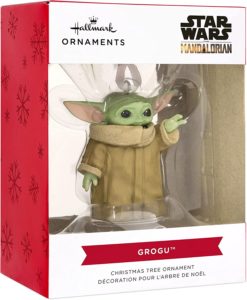 With the explosion of media from big-name franchises like Star Wars, Marvel, and Lord of the Rings there is almost too much for one person to consume. However, some will say there is never enough of their favorite setting. For those folks, or friends of those folks who need gift ideas, I present the following list of thematic boardgames. Each captures the flavor of the settings, supported by a quality, enjoyable boardgame underneath. They’re not just a copy of Monopoly with scenes from a movie slapped on top.
With the explosion of media from big-name franchises like Star Wars, Marvel, and Lord of the Rings there is almost too much for one person to consume. However, some will say there is never enough of their favorite setting. For those folks, or friends of those folks who need gift ideas, I present the following list of thematic boardgames. Each captures the flavor of the settings, supported by a quality, enjoyable boardgame underneath. They’re not just a copy of Monopoly with scenes from a movie slapped on top.
Star Wars remains one of the biggest franchises around. Plenty of mass market games have a version with “Star Wars” slapped on the front. However, I would call your attention to two standouts.
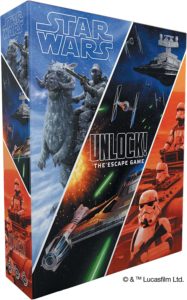 Star Wars: Unlock is an “escape room in a box” where players scan through a deck of cards, supplemented by a digital app, in order to solve puzzles hidden on the cards, which reveal more cards, and so on until the mystery is solved. There are three different adventures in the box and while there is no sense in experiencing the game a second time, there are no permanent changes to the materials so the game can be passed on to a friend to play.
Star Wars: Unlock is an “escape room in a box” where players scan through a deck of cards, supplemented by a digital app, in order to solve puzzles hidden on the cards, which reveal more cards, and so on until the mystery is solved. There are three different adventures in the box and while there is no sense in experiencing the game a second time, there are no permanent changes to the materials so the game can be passed on to a friend to play.
 If playing bad guys is your thing, look no further than Star Wars Villainous: Power of the Dark Side. Players take on the role of famous bad-guys: Darth Vader, Asajj Ventress, Kylo Ren, Moff Gideon, or General Grievous – each with their own unique powers and goals. Move around the board playing cards from your private themed-deck either to help yourself or hinder another. You even play your opponents cards on them – giving them a nice, personalized obstacle to overcome.
If playing bad guys is your thing, look no further than Star Wars Villainous: Power of the Dark Side. Players take on the role of famous bad-guys: Darth Vader, Asajj Ventress, Kylo Ren, Moff Gideon, or General Grievous – each with their own unique powers and goals. Move around the board playing cards from your private themed-deck either to help yourself or hinder another. You even play your opponents cards on them – giving them a nice, personalized obstacle to overcome.
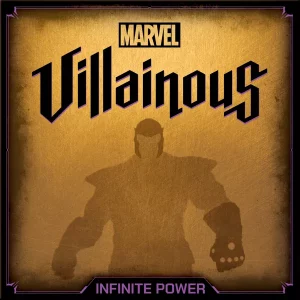 It seems like every game is coming up Marvel-themed. There is a Marvel brand game for almost any player’s taste. Highlights include Marvel Villainous: Infinite Power – another Villainous game where you take on the role of Hela, Killmonger, Taskmaster, Thanos, or Ultron.
It seems like every game is coming up Marvel-themed. There is a Marvel brand game for almost any player’s taste. Highlights include Marvel Villainous: Infinite Power – another Villainous game where you take on the role of Hela, Killmonger, Taskmaster, Thanos, or Ultron.
 Marvel: Remix is a short card-collecting game where players try to accumulate sets of hero cards to score points. However, unlike games like Rummy, the collected cards also decide how a player scores. One player may be gaining points for lots of villains while another scores points for each X-Men in their hand.
Marvel: Remix is a short card-collecting game where players try to accumulate sets of hero cards to score points. However, unlike games like Rummy, the collected cards also decide how a player scores. One player may be gaining points for lots of villains while another scores points for each X-Men in their hand.
 Smash Up: Marvel has players mixing two themed card decks into a single combined one. Pick two of: The Ultimates, HYDRA, The Avengers, Masters of Evil, S.H.I.E.L.D., The Kree, Spider-Verse, and the Sinister Six and then shuffle them together. Want The Avengers to team up with The Kree? Just shuffle them together. Players play cards from their decks in order to take over one of three locations and score points. The catch, if you will, is that most cards and locations have special abilities so they can key off of each other and make interesting combinations of effects.
Smash Up: Marvel has players mixing two themed card decks into a single combined one. Pick two of: The Ultimates, HYDRA, The Avengers, Masters of Evil, S.H.I.E.L.D., The Kree, Spider-Verse, and the Sinister Six and then shuffle them together. Want The Avengers to team up with The Kree? Just shuffle them together. Players play cards from their decks in order to take over one of three locations and score points. The catch, if you will, is that most cards and locations have special abilities so they can key off of each other and make interesting combinations of effects.
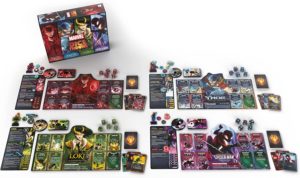 The frequency Marvel Dice Throne is compared to “advanced” Yahtzee has almost become cliche. However, it remains the quickest way to describe it to a general audience. Players take on the role of a Marvel hero or villain (in the base game: Scarlet Witch, Loki, Thor, Doctor Strange, and Miles Morales Spider-man. There are a couple of stand-alone 2-character expansion packs, with Black Panther, Captain Marvel, Black Widow) and then battle it out with one or more opponents. There are also a few stand alone 2-character packs To attack, a player will roll five dice and set some aside, then roll again – setting more dice aside, and then one final roll. After all rolls are complete, the result is used to key up an attack to damage one’s opponent. The best part of the game lies in the variety of attacks and options. In general, rolling lots of “a-kind” is good, as is a full house, small, or large straight. The fun bit comes in as each character has different special effects that can happen. Thor has a cute little hammer he throws and pings other players for 1 point of damage, but can be called back to draw another card – there are personal card decks for each character which can be played when spending resources. Other abilities include poison (ongoing damage) and ways (several types) of avoiding an opponent’s attacks. Roll all 6’s and a character unleashes its most powerful, unblockable, special attack. Typically with decent damage but all sorts of bonus effects. The key to doing well is to recognize and take advantage of each specific character’s special abilities. With lots of dice there is some randomness, but battles only last 30 minutes or so, in keeping with the fast pace of play. All of a character’s powers and special abilities are provided in a handy fold-out chart to make it easier to just pull out a character and play. The entire game is based off the game Dice Throne which has over a dozen other characters which are also compatible with the Marvel version.
The frequency Marvel Dice Throne is compared to “advanced” Yahtzee has almost become cliche. However, it remains the quickest way to describe it to a general audience. Players take on the role of a Marvel hero or villain (in the base game: Scarlet Witch, Loki, Thor, Doctor Strange, and Miles Morales Spider-man. There are a couple of stand-alone 2-character expansion packs, with Black Panther, Captain Marvel, Black Widow) and then battle it out with one or more opponents. There are also a few stand alone 2-character packs To attack, a player will roll five dice and set some aside, then roll again – setting more dice aside, and then one final roll. After all rolls are complete, the result is used to key up an attack to damage one’s opponent. The best part of the game lies in the variety of attacks and options. In general, rolling lots of “a-kind” is good, as is a full house, small, or large straight. The fun bit comes in as each character has different special effects that can happen. Thor has a cute little hammer he throws and pings other players for 1 point of damage, but can be called back to draw another card – there are personal card decks for each character which can be played when spending resources. Other abilities include poison (ongoing damage) and ways (several types) of avoiding an opponent’s attacks. Roll all 6’s and a character unleashes its most powerful, unblockable, special attack. Typically with decent damage but all sorts of bonus effects. The key to doing well is to recognize and take advantage of each specific character’s special abilities. With lots of dice there is some randomness, but battles only last 30 minutes or so, in keeping with the fast pace of play. All of a character’s powers and special abilities are provided in a handy fold-out chart to make it easier to just pull out a character and play. The entire game is based off the game Dice Throne which has over a dozen other characters which are also compatible with the Marvel version.
Star Trek hasn’t gotten as much love as Star Wars and Marvel, but there are still a few good Trek and Trek-adjacent out there for your Trekkie loved one.
 Star Trek: Super-Skill Pinball is a set of Trek themed tables that use the Super-Skill Pinball mechanics. One player rolls a die and then all players move a little “ball” marker around on a playfield card. The “ball” tends to fall downward on the card and “flippers” can be used (with the right roll of the die) to shoot the ball back up onto the playfield. The simultaneous play does a surprisingly good job of letting players feel like they’re playing a game of pinball. Four tables are provided: Starfleet Academy, The Trouble with Tribbles, Lower Decks, and Borg Attack. Each table has special features that can be triggered to create effects not found on the other tables.
Star Trek: Super-Skill Pinball is a set of Trek themed tables that use the Super-Skill Pinball mechanics. One player rolls a die and then all players move a little “ball” marker around on a playfield card. The “ball” tends to fall downward on the card and “flippers” can be used (with the right roll of the die) to shoot the ball back up onto the playfield. The simultaneous play does a surprisingly good job of letting players feel like they’re playing a game of pinball. Four tables are provided: Starfleet Academy, The Trouble with Tribbles, Lower Decks, and Borg Attack. Each table has special features that can be triggered to create effects not found on the other tables.
 Star Trek: Ascendancy is the most complex game on this list, spanning several hours. Players take on the role of a faction (Federation, Klingons, and Romulans in the base game) and proceed to explore the galaxy, build up their manufacturing, and then go out and attack the others (although a peaceful economic win is also possible.) It’s been out for awhile but there are a few new factions available which include the Dominion (which plays its own part of the board for awhile until someone crosses the wormhole) and the Breen (who are exceptionally strong at home, but less powerful as they head out to the front lines.) Ascendancy is best fit for gamers looking for a longer game with strong similarities to videogames like Civilization.
Star Trek: Ascendancy is the most complex game on this list, spanning several hours. Players take on the role of a faction (Federation, Klingons, and Romulans in the base game) and proceed to explore the galaxy, build up their manufacturing, and then go out and attack the others (although a peaceful economic win is also possible.) It’s been out for awhile but there are a few new factions available which include the Dominion (which plays its own part of the board for awhile until someone crosses the wormhole) and the Breen (who are exceptionally strong at home, but less powerful as they head out to the front lines.) Ascendancy is best fit for gamers looking for a longer game with strong similarities to videogames like Civilization.
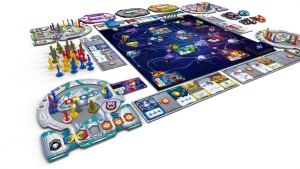 Starship Captains was just released and while it isn’t “official” canon, there are strong Trek overtones to the game. Players place crew markers of colors (surprise) red, yellow, and blue into rooms of their ship in order to trigger actions (this is often called worker-placement in boardgame terminology.) These actions include upgrading one’s ship (possibly adding rooms), upgrading and expanding one’s crew, exploring the galaxy, etc… each activity tends to score victory points. The variety of strategic options (and variable game setup) means no two games will be quite alike. There are no direct Trek references, but many game systems (like the colors) and themes will resonate with a Trekkie.
Starship Captains was just released and while it isn’t “official” canon, there are strong Trek overtones to the game. Players place crew markers of colors (surprise) red, yellow, and blue into rooms of their ship in order to trigger actions (this is often called worker-placement in boardgame terminology.) These actions include upgrading one’s ship (possibly adding rooms), upgrading and expanding one’s crew, exploring the galaxy, etc… each activity tends to score victory points. The variety of strategic options (and variable game setup) means no two games will be quite alike. There are no direct Trek references, but many game systems (like the colors) and themes will resonate with a Trekkie.
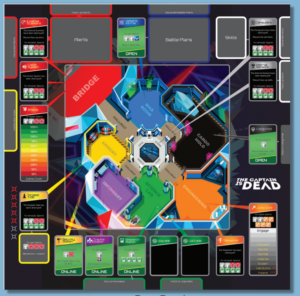 The Captain is Dead is an older game, but this cooperative game captures most of the feel of the last 10 minutes of a Star Trek episode where everything has gone wrong. Players take on the role of a member of the crew and try to move (run!) around the gameboard ship trying to put out fires (literally and figuratively.) The crew is trying to fix the jump engines in time to jump out of there before the invading alien ships manage to take control or destroy the ship (from within or without.) The strongest tie-in to Trek is in the many (over a dozen) different playable characters in the game. Their special in-game abilities will make immediate sense to anyone familiar with Star Trek. Two of my favorites are the (red-shirted) crew member and the hologram. Whenever someone is attacked who is in the same room as the red-shirt crew member, the red shirt “dies” instead and a new one pops back up again in the crew quarters on their next turn. The hologram is worth almost two other characters in power, however if the holo-projectors go offline (which they frequently do) they are trapped in the computer core until someone can fix them. Despite the lack of an official Trek link, the game has more Star Trek theme than others that have Star Trek in the title.
The Captain is Dead is an older game, but this cooperative game captures most of the feel of the last 10 minutes of a Star Trek episode where everything has gone wrong. Players take on the role of a member of the crew and try to move (run!) around the gameboard ship trying to put out fires (literally and figuratively.) The crew is trying to fix the jump engines in time to jump out of there before the invading alien ships manage to take control or destroy the ship (from within or without.) The strongest tie-in to Trek is in the many (over a dozen) different playable characters in the game. Their special in-game abilities will make immediate sense to anyone familiar with Star Trek. Two of my favorites are the (red-shirted) crew member and the hologram. Whenever someone is attacked who is in the same room as the red-shirt crew member, the red shirt “dies” instead and a new one pops back up again in the crew quarters on their next turn. The hologram is worth almost two other characters in power, however if the holo-projectors go offline (which they frequently do) they are trapped in the computer core until someone can fix them. Despite the lack of an official Trek link, the game has more Star Trek theme than others that have Star Trek in the title.
Tie-ins are not just for the big names, stand-out movies or television series also get their due.
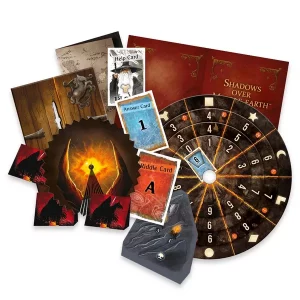 Exit: The Game – The Lord of the Rings: Shadows over Middle-earth is another take on the escape-room-in-a-box with a LotR theme. Unlike Unlock!, the Exit games are one-use only so be prepared to cut up or write on bits in order to solve the puzzles. Exit games typically don’t need an accompanying app either. The downside is that they’re consumable so can’t be passed on to a friend.
Exit: The Game – The Lord of the Rings: Shadows over Middle-earth is another take on the escape-room-in-a-box with a LotR theme. Unlike Unlock!, the Exit games are one-use only so be prepared to cut up or write on bits in order to solve the puzzles. Exit games typically don’t need an accompanying app either. The downside is that they’re consumable so can’t be passed on to a friend.
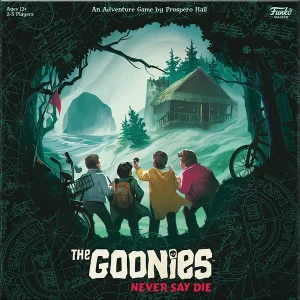 The Goonies: Never Say Die has players cooperatively exploring locations from the movie and working against challenges or villains present. There are nine different adventures in the base game with The Goonies: Under the Goondocks – A Never Say Die Expansion providing three more.
The Goonies: Never Say Die has players cooperatively exploring locations from the movie and working against challenges or villains present. There are nine different adventures in the base game with The Goonies: Under the Goondocks – A Never Say Die Expansion providing three more.
 Fast & Furious: Highway Heist is another fun cooperative game where players play through one of several scenarios, all of which are based around careening down a highway. Examples include robbing a moving van, stopping a runaway tank, and knocking down a high-tech chopper. Players take on the role of stand-out characters from the series, each with their own special abilities, which are then modified slightly based on which car they choose to drive. Play consists of making dice skill checks and using special abilities while a game-timer (based on the number of those skill checks & abilities used) counts down to the end of the scenario.
Fast & Furious: Highway Heist is another fun cooperative game where players play through one of several scenarios, all of which are based around careening down a highway. Examples include robbing a moving van, stopping a runaway tank, and knocking down a high-tech chopper. Players take on the role of stand-out characters from the series, each with their own special abilities, which are then modified slightly based on which car they choose to drive. Play consists of making dice skill checks and using special abilities while a game-timer (based on the number of those skill checks & abilities used) counts down to the end of the scenario.


Netflix is now in on the boardgame front with the small games (suitable for a stocking?) based on Squid Game or Stranger Things: Attack of the Mind Flayer. The former has players attempting silly simple games based on the series while the latter is a sort of deduction game whereby some players are secretly possessed and are working against all the other players without revealing their true nature.
 Finally, we have the Jurassic Park movies. Jurassic World: Legacy of Isla Nublar has players progressing through the various films in an ongoing, changing set of rules and pieces played over a series of games. As each game is played, something is changed from the previous rules possibly including entirely new win conditions. While the setup (several games, played in a series) is similar to some meaty games called “Legacy” games, this one leans a bit more on the lighter side. Still some gaming crunch, but a significant source of fun is the development of your group’s personalized in-game story as you play.
Finally, we have the Jurassic Park movies. Jurassic World: Legacy of Isla Nublar has players progressing through the various films in an ongoing, changing set of rules and pieces played over a series of games. As each game is played, something is changed from the previous rules possibly including entirely new win conditions. While the setup (several games, played in a series) is similar to some meaty games called “Legacy” games, this one leans a bit more on the lighter side. Still some gaming crunch, but a significant source of fun is the development of your group’s personalized in-game story as you play.
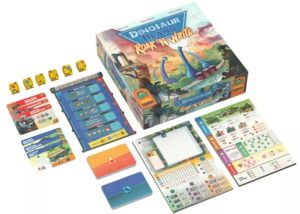 Dinosaur Island: Rawr ‘n Write is not a direct tie-in but has all the feel of a true Jurassic Park game, as players attempt to build the best dino theme park, measured by scoring the most points. Someone rolls a set of special dice, and then players take turns drafting them in order to use their special abilities to gain DNA (to make dinos) or money (to build buildings or hire help.) These dice are then used to take actions to make those purchases. Whatever you construct (other than hiring help) needs to be drawn on a player’s personal park grid in sort of a Tetris style. However, no two buildings can be touching. Players also construct roads between their “Tetris” buildings and three times during the game a virtual “tour” is run, scoring bonus points and resources along the way. Many actions in the game are simultaneous, which keeps the game moving at a fast pace. Even though the game revolves around rolling dice and drawing boxes on a grid, it manages to provide the feeling of running your own dino amusement park.
Dinosaur Island: Rawr ‘n Write is not a direct tie-in but has all the feel of a true Jurassic Park game, as players attempt to build the best dino theme park, measured by scoring the most points. Someone rolls a set of special dice, and then players take turns drafting them in order to use their special abilities to gain DNA (to make dinos) or money (to build buildings or hire help.) These dice are then used to take actions to make those purchases. Whatever you construct (other than hiring help) needs to be drawn on a player’s personal park grid in sort of a Tetris style. However, no two buildings can be touching. Players also construct roads between their “Tetris” buildings and three times during the game a virtual “tour” is run, scoring bonus points and resources along the way. Many actions in the game are simultaneous, which keeps the game moving at a fast pace. Even though the game revolves around rolling dice and drawing boxes on a grid, it manages to provide the feeling of running your own dino amusement park.
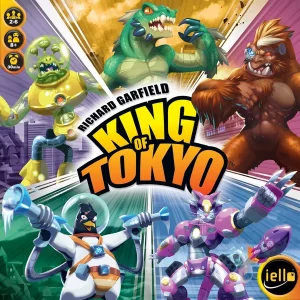 Possibly the “oldest” game on this list, King of Tokyo is the definitive monster-battling game to which others only aspire. Players choose a monster (giant robot bunny, giant panda, “godzilla”, giant ape, and others) and then take turns rolling dice Yahtzee-style (roll 3 times, keeping ones you like) to score points, gain energy (resources), heal, and (of course) attack the other monsters. The first to 20 points wins the game, but more often than not the winner is simply the last monster standing. That energy gained can be used to buy cards that provide extra points or special powers. Some are cheap, like a bonus point or two or minor ability, but others are more costly but are much more powerful. “Two Heads” gives a player an additional die to roll while another card poisons monsters and makes it harder for them to heal. Appropriate to the mechanics and subject matter, the game plays fast and a quick game can easily be played in under an hour. Time enough for your monster titans to rage into Tokyo once again.
Possibly the “oldest” game on this list, King of Tokyo is the definitive monster-battling game to which others only aspire. Players choose a monster (giant robot bunny, giant panda, “godzilla”, giant ape, and others) and then take turns rolling dice Yahtzee-style (roll 3 times, keeping ones you like) to score points, gain energy (resources), heal, and (of course) attack the other monsters. The first to 20 points wins the game, but more often than not the winner is simply the last monster standing. That energy gained can be used to buy cards that provide extra points or special powers. Some are cheap, like a bonus point or two or minor ability, but others are more costly but are much more powerful. “Two Heads” gives a player an additional die to roll while another card poisons monsters and makes it harder for them to heal. Appropriate to the mechanics and subject matter, the game plays fast and a quick game can easily be played in under an hour. Time enough for your monster titans to rage into Tokyo once again.
No list is complete, and it is likely that your favorite IP has produced a game somewhere. However, the games above are not just another mediocre game with a pasted-on popular theme to draw you in. They all stand on their own merit and would be a great game for that mega-fan gamer in your life.





Discussion Area - Leave a Comment